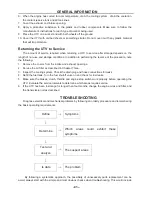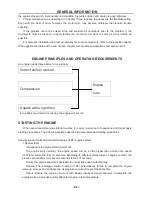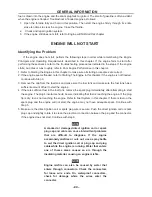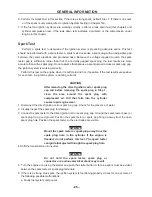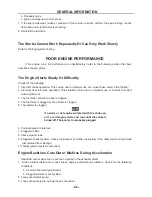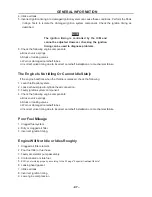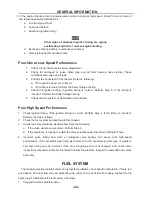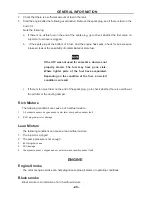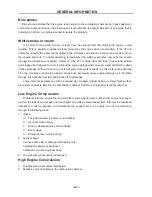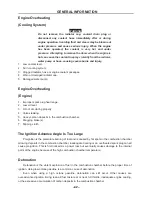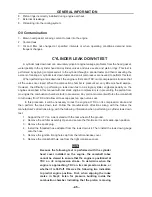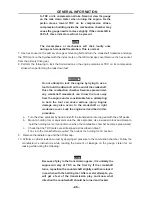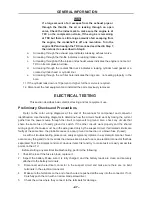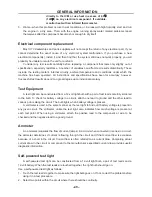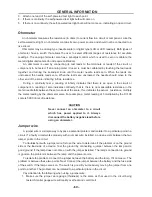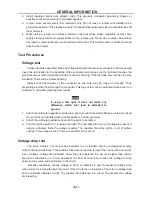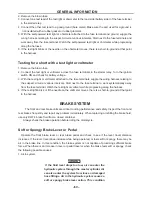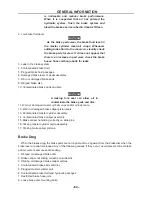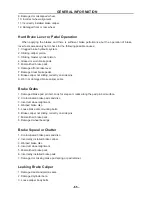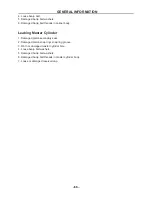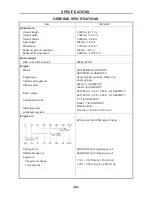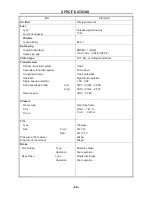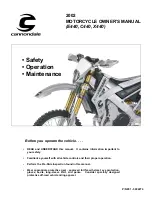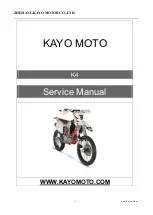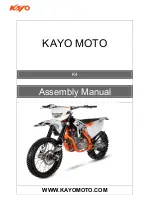
-45-
GENERAL INFORMATION
- 45 -
6. Piston rings incorrectly installed during engine overhaul.
7. External oil leakage.
8. Oil leaking into the cooling system.
Oil Contamination
1. Blown head gasket allowing coolant to leak into the engine.
2. Coolant leak.
3. Oil and filter not changed at specified intervals or when operating conditions demand more
frequent changes.
CYLINDER LEAK DOWN TEST
A cylinder leak down test can accurately pinpoint engine leakage problems from the head gasket,
water jackets in the cylinder head and cylinder, valves and valve seats, and piston rings. This test is
performed by applying compressed air to the cylinder through a special tester and then measuring the
percent of leakage. A cylinder leak down tester and an air compressor are needed to perform this test.
When performing a leak down test, the engine is first set at TDC on its compression stroke so that
all the valves are closed. When the combustion chamber is pressurized, very little air should escape.
However, the difficulty in performing a leak down test on a single cylinder engine(especially on the
engines described in this manual with low static engine compression) is in preventing the piston from
moving as the combustion chamber starts to pressurize. Any piston movement will force the crankshaft
to turn away from TDC and allow air to escape past an open valve seat.
In this procedure it will be necessary to lock the engine at TDC on its compression stroke and
then perform the leak down test. Follow the manufacturer’s directions along with the follow the
manufacturer’s directions along with the following information when performing a cylinder leak down
test.
1. Support the UTV on a work stand with the rear wheel off the ground.
2. Remove the air filter assembly Open and secure the throttle so it is at its wide-open position.
3. Remove the spark plug.
4. Install the threaded hose adapter from the leak down kit. Then install the leak down gauge
onto the hose.
5. Remove the ignition timing hole cap from the left crankcase cover.
6. Remove the crankshaft hole cap from the right crankcase cover.
NOTE
Because the following test is performed with the cylinder
head cover installed on the engine, the camshaft lobes
cannot be viewed to ensure that the engine is positioned at
TDC on its compression stroke. To determine when the
engine is approaching TDC on its compression stroke, or
whether it is 360°off. Observe the following two indicators
to predict engine position. First, when aligning the index
marks in Step7, listen for pressure building inside the
combustion chamber. Indicating that the piston is moving
Summary of Contents for HS200UTV
Page 3: ......
Page 15: ......
Page 94: ... 79 SPECIFICATIONS 79 HYDROGRAPHIC CHART Hydrographic chart Pressure ...
Page 95: ... 80 SPECIFICATIONS 80 LUBRICATION OIL WAY LUBRICATION OIL WAY Pressure splashing oil ...
Page 248: ... 233 CHASSIS 233 Fuel tank cap Remove the fuel tank cap by turning it counterclockwise ...
Page 263: ... 248 ...
Page 304: ... 289 ...
Page 305: ... 290 ...
Page 306: ... 291 ...
Page 307: ... 292 ...
Page 308: ... 293 ...
Page 309: ... 294 ...
Page 310: ... 295 ...
Page 311: ... 296 ...

